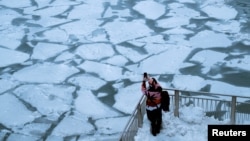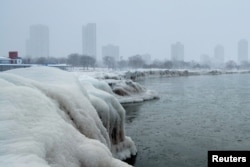Farmers from North Dakota to Iowa buckled down for some of the coldest weather in a generation on Wednesday, throwing extra rations to pigs or building igloos for chickens before hunkering down for a day of sub-zero temperatures and bone-chilling winds.
Some, like Kurt Line in Indiana, joked about the forecast. Line said he looked forward to working on his tax returns, something he usually puts off, rather than braving the cold to load corn for a local processing plant.
But temperatures expected to plunge in some areas as low as minus 40 degrees, the point at which Fahrenheit and Celsius converge, are no laughing matter for an industry dependent on the elements. The brutal chill was caused by the polar vortex, a mass of freezing air that normally spins around the North Pole but has made its way south to the United States.
Cattle ranchers Joey Myers and her fiancé, Scott Bailey, in Minot, North Dakota, were brewing coffee with plans to stay up all night as long as the cold lasted to check on their animals.
“We’ll be doing the same tonight, tomorrow night and the night after that,” said Myers, who added the couple were breaking out their ski masks and ski goggles to protect their faces from the cold.
They feared the minus 18-degree F ( minus 28-C) temperatures with wind chills of minus 50 degrees F ( minus 45 C) could cause their pregnant cows to give birth early. Their heated barn is not big enough to house every animal, so they must keep watch for newborn calves to prevent fatalities.
Ron Prestage, president of one of Iowa’s biggest hog producers, Prestage Farms, said his company had been stocking up on feed to last at least until Friday, and was making sure heaters and water lines were running at hog barns.
“When it gets cold, they eat more,” he said in a phone interview. So we just have to make sure we plan ahead.”
“As cold as it’s going to be, water lines are a critical factor,” he added.
Also in Iowa, Deanna Brennecke said she knew the cold was coming days before the local TV weather reports: Her cattle had been eating far more feed and putting on weight to help keep themselves warm as the temperatures plummeted.
“They were meeting us at the gate, and filling themselves full, and we just knew,” said Brennecke, who runs her family’s cow-calf farm and raises goats with her husband in Decatur County.
VASELINE AND CHICKEN SKIN
The cold weather was also a concern for small-scale farmers.
In Wisconsin, where temperatures were heading toward minus 30 degrees F ( minus 34 C), dairy farmer Amber McComish and her family stocked up on extra fuel for the generator for their milking barn, tucked the baby calves into a heated room and made sure all the animals had food and water.
Backyard chicken owners in the Midwest flocked online for advice on how to protect their birds, with some on the chat forum at BackyardChickens.com asking if they should add a heating pad for their poultry to stand on.
Others suggested putting extra tarps around the coops to keep chickens dry and coating exposed chicken skin with petroleum jelly to ward off frostbite.
In Chicago, Lynn Ankney and her family have been double-checking their backyard coop, making sure there are no drafts around their Rhode Island Red and Black Australorp hens – and using snow that accumulated in recent days to build an igloo around their coop for extra insulation.
“We’re keeping a close eye on them,” said Ankney.














